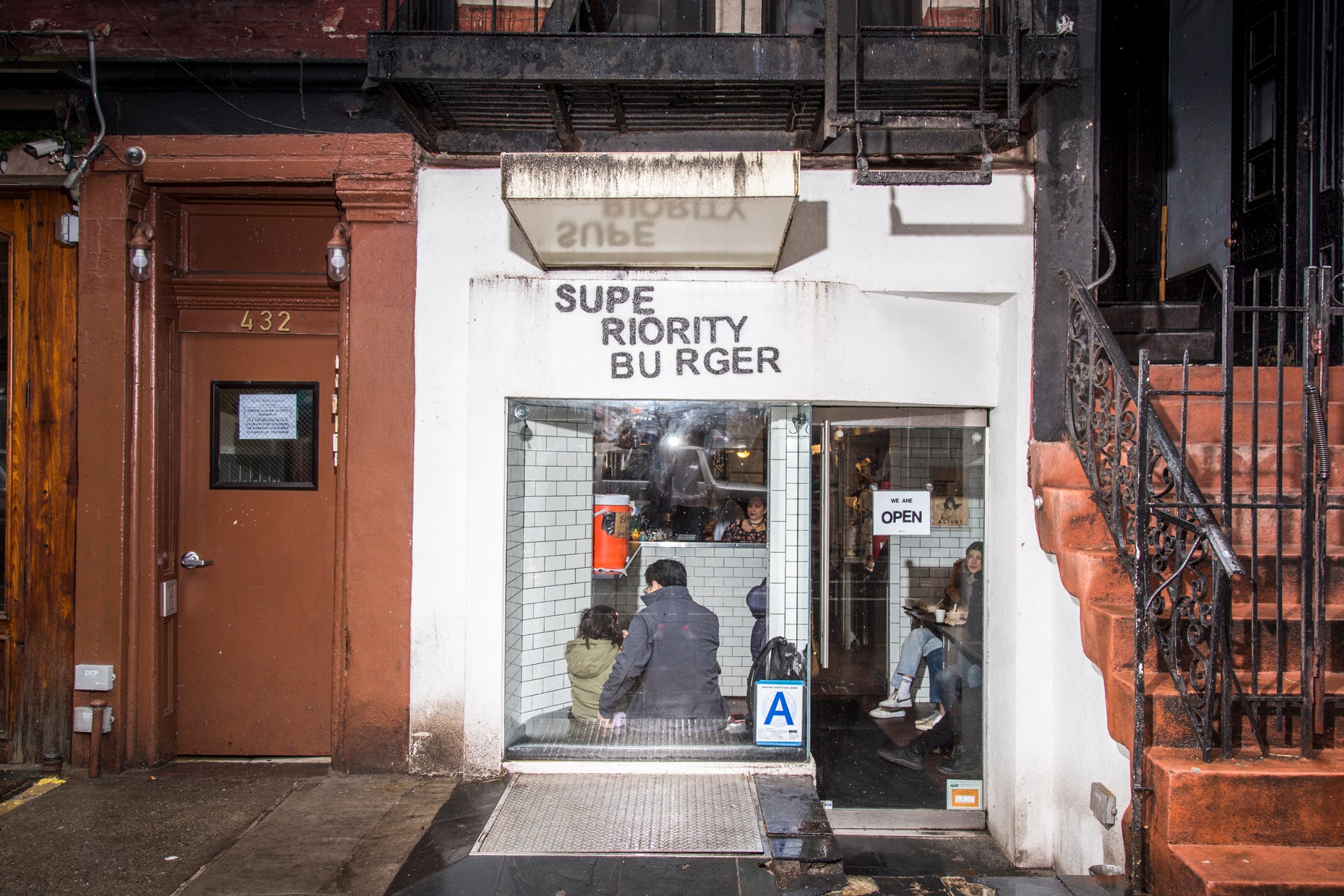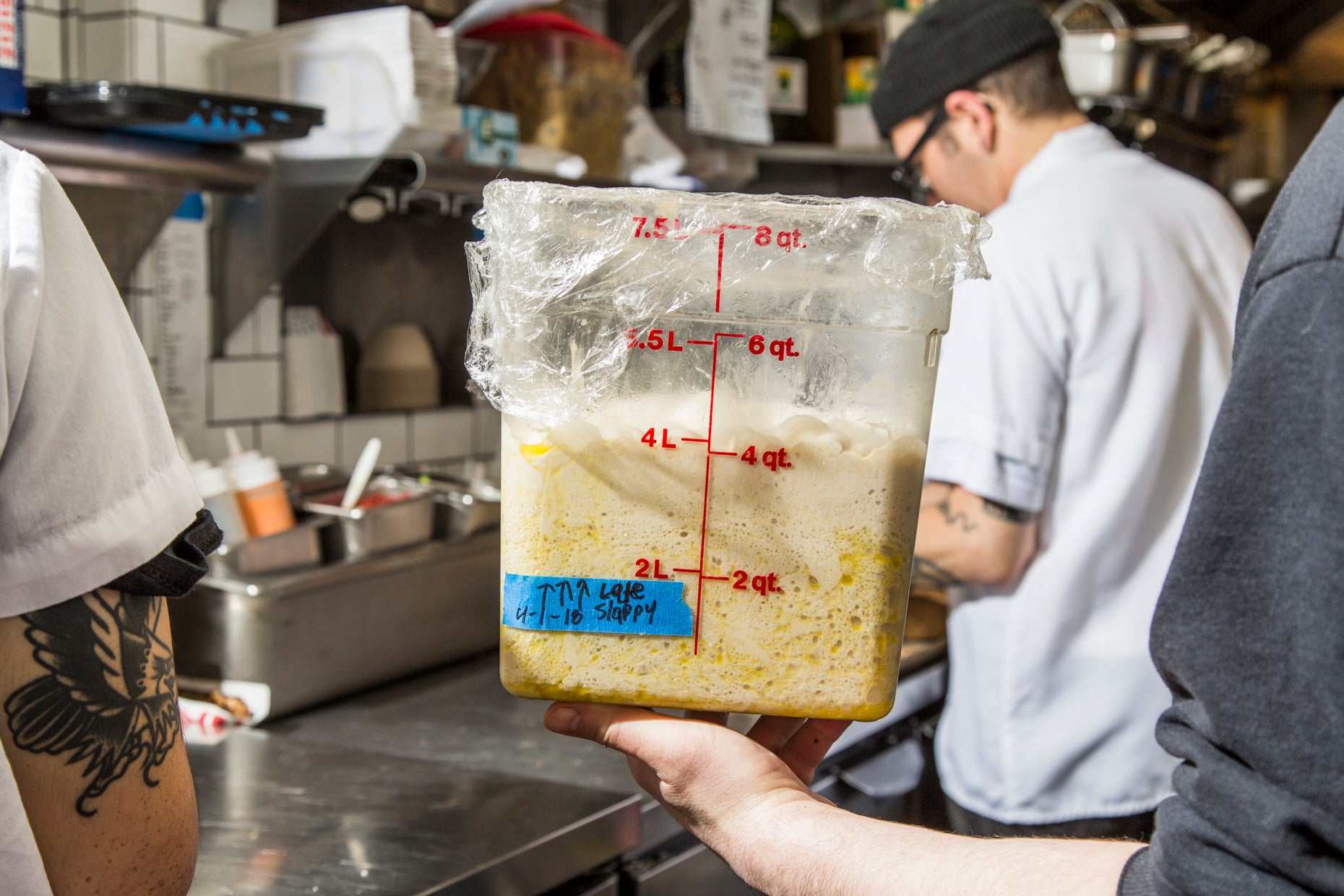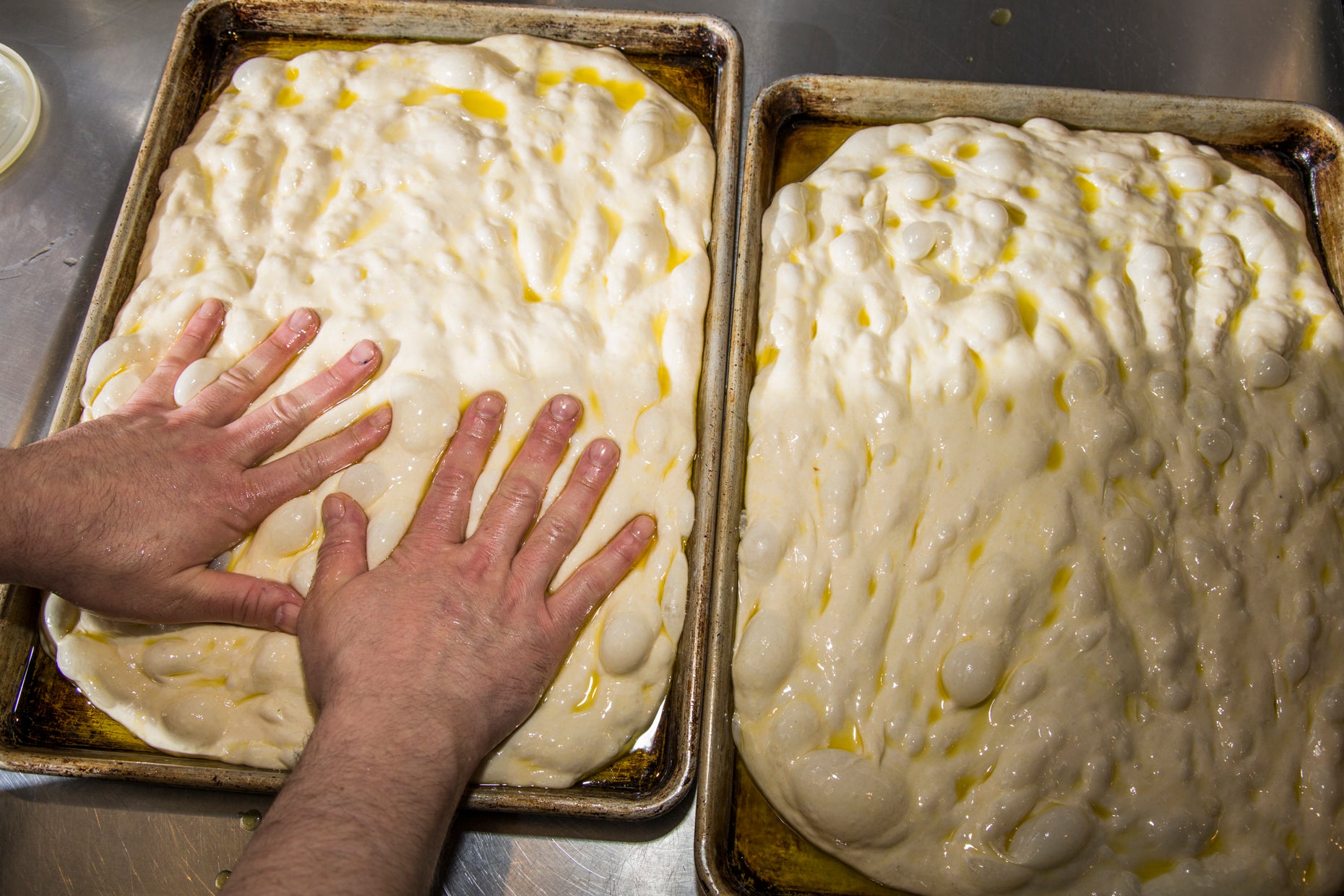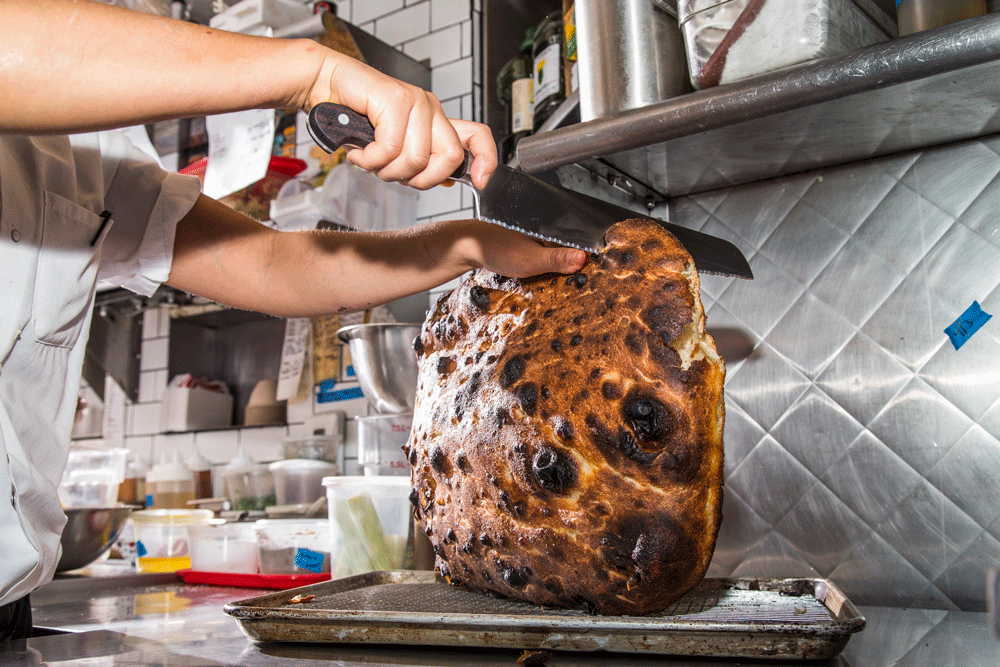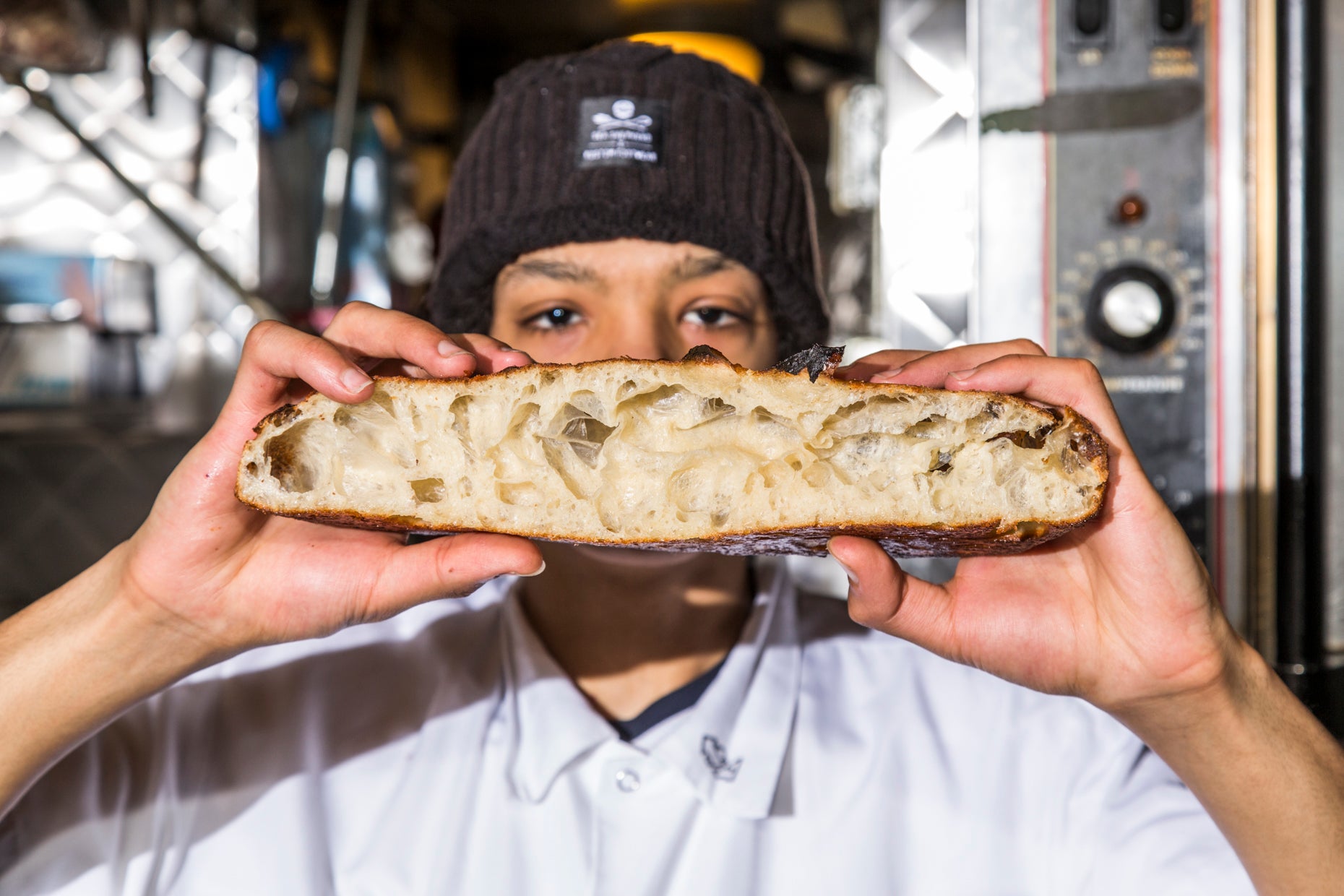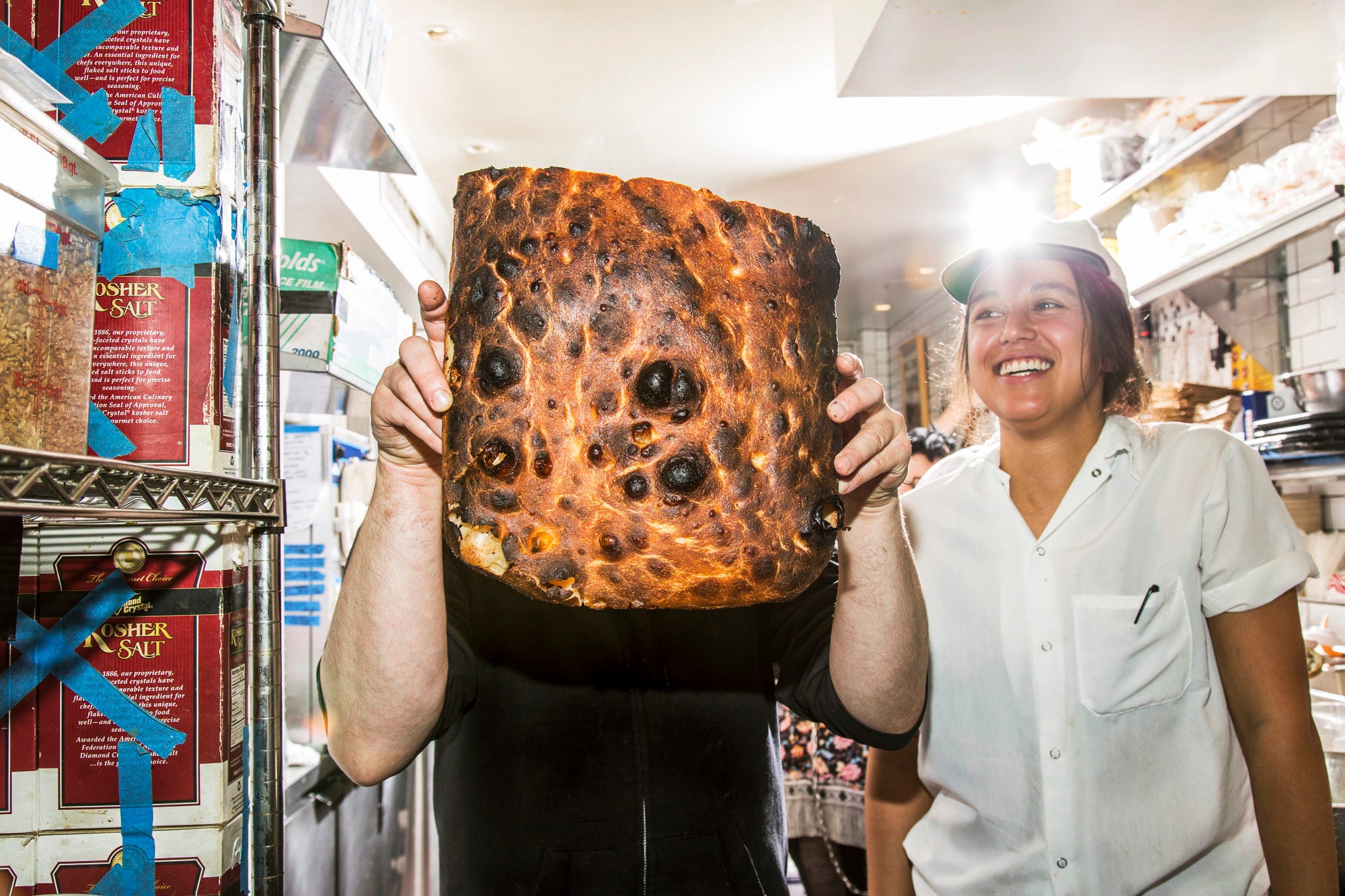
First it was pastry; next it was veggie burgers and vegan pyrotechnics. But the biggest challenge ahead is mastering Italian olive oil bread.
Brooks Headley is stressed.
Standing in the cramped interior of his East Village vegetarian restaurant, Superiority Burger, he’s describing how a promising batch of focaccia dough has just fallen on the floor in the midst of preparing a large catering order—while another batch has risen in half the time it was supposed to. He presents the two mounds of dough on the counter like they are science experiments, pointing out the gentle, uniform bubbles in one and the plump, taffy-like texture of the other. All good signs, but he’s still not sure if either will turn out in the oven.
“We are not in control of it,” he says of the dough before him. “It is in control of us.”
Situations like these have become the new normal for Headley and his staff, who, since August, have been attempting to perfect focaccia—the deceptively difficult, olive-oil-laden Italian bread.
Over the last several years, and to great acclaim, Headley dedicated most of his waking hours to making the best possible veggie burger—and by every account, he succeeded. His squishy, hearty, Martin’s Potato Roll–encased creation is one of the best meatless burgers in the city and the star of Headley’s upcoming book, Superiority Burger Cookbook: The Vegetarian Hamburger Is Now Delicious, out in June.
So with the veggie burger under his belt, he has found a new all-consuming project in focaccia. But the goal here is not financial—there are no clear plans for a stand-alone focaccia restaurant (though that could be awesome), or even a focaccia sandwich on the menu. Like the modest Superiority Burger enterprise—a mostly standing-room-only nook on East 9th Street serving breathtaking preparations of vegetables in humble paper boats, and with no expansion plans—this bread is an intellectual passion project for Headley. “When this focaccia is good, it’s the best,” he tells me. “It’s better than anything I have ever had.” He describes the platonic ideal of focaccia with a gleam in his eye: “Incredibly light, super flavorful from the semolina, a pillowy interior, a crispy crust. It’s amazing. This isn’t about commerce for me.”
The seeds of this focaccia project were planted in 2016, when Headley first tasted the Roman-style pizzas of renowned Pittsburgh baker Rick Easton at the short-lived Bread and Salt stand at the Brooklyn food hall Berg’n. “The bottom of the crust was like glass. It was super crisp and browned,” he recalls of the exceptional bread. “And the crumb structure was so delicious and light. It was like there was nothing there, like you were eating air.”
Headley had tested out making his own bread, but he was particularly curious about focaccia. The bread is ubiquitous as a freebie at restaurants because it’s easy to love—speckled with salt, soaked in oil, crunchy like a corner slice of Sicilian-style pizza. But Headley wasn’t impressed with any of the versions he had tried. They were, in his words, “dense, cakey, and really bad.” Which is to say: There was room for improvement. Plus, making focaccia didn’t require any special equipment.
He asked Easton for a focaccia recipe, and Easton, who was a big fan of Superiority Burger, offered to do Headley one better: to come in and teach the entire staff how to make the bread, and to develop a method built specifically for Headley’s small East Village kitchen. “I loved that Superiority Burger was this subversive restaurant serving such beautiful, thoughtful food and convincing everyone it was fast food,” Easton says. “I told him that instead of giving him a recipe, what was more important was learning what the dough is supposed to feel, smell, and taste like at every stage of development.” The challenge, he adds, is that “Superiority Burger is a small space designed to make veggie burgers and salads—you only have so much control. But the thing is that bread is highly dependent on controlling time and temperature.”
Easton’s modified, and exacting, focaccia uses commercial yeast, gets blended in a small stand mixer (to be exact, a semi-broken seven-quart commercial KitchenAid Headley received as a prize from Dessert Professional Magazine in 2013), and can be baked in a convection oven—which is built with fans that circulate air for faster cooking, versus a bread oven, which is designed not for speed but to create a hot, moist environment to ensure a crackly, thick crust. It’s a process that is within reach of a home baker more so than other restaurant bread and pastry recipes.
But there are corners that cannot be cut: His method calls for a high-quality olive oil (Headley swears by Il Tratturello Extra Virgin Olive Oil) and 75 percent semolina flour for a more intense flavor. It also requires repetitive folding of the dough to keep it airy, and has a several-days-long fermentation process, which yields bread that’s fluffy and tender yet hearty and easy to digest. If this sounds like a bad business idea—multiple days’ prep, expensive ingredients, no clear way to sell it—that’s because it is.
“We are trying to master an extremely inefficient and time-consuming thing that may or may not become a thing we can sell for money,” says Headley with a laugh. And as opposed to making veggie burgers, where you can taste the raw batter and if it didn’t taste good you can adjust it and know the end result will be better, with focaccia, “you just don’t know.”
The cooks of the 13-person staff take turns making focaccia, working in a small station in a retail storefront across the street with covered-up windows that Headley has turned into a prep space for the restaurant. Headley and his staff follow Easton’s instructions as if they were religious creeds. They add ice water to the dough as it mixes to regulate the temperature, so the yeast stays active. They only stop mixing when the dough passes the “window test”—when you can stretch the dough and it will form a thin, translucent window, which means the gluten has formed and dough is ready to begin the fermentation process. Once the dough has doubled in size and developed little air pockets, it gets placed on a sheet pan (“This part is like picking up a cat,” Headley says), and then Headley uses the top part of his palm (again, an Easton trick) to create little dimples, which help to distribute the air during the baking process.
Then comes the brine—a mixture of olive oil, salt, and water called salamoia that Headley says is “like a salad dressing for bread”—which he rubs onto the dough. This process ensures that every section is evenly covered in salt.
The last step is the baking, which takes place in the “terrible, crappy convection oven that is definitely not supposed to bake bread” (Headley’s words) in the back of the Superiority Burger storefront.
“I can’t stress enough that we are totally incompetent at making bread,” Headley jokes. “It’s just Rick teaching a bunch of nincompoops how to do something.”
At that moment, as if on cue, the faulty KitchenAid that’s mixing focaccia dough burps out a blackish ooze into the bowl, immediately turning the dough a questionable gray color. After 20 minutes of careful mixing, Darcy Spence, the cook charged with making the dough that day, turns to me, sighs, and says, “This happens a lot with this mixer. We’re going to have to throw this batch out.”
These sorts of failures have become routine during Superiority Burger’s focaccia experiments. Headley rattles off a laundry list of things that go wrong: The focaccia becomes too dense when it bakes; or it looks light and airy on top but is thick on the bottom; or the dough never rises, even after a week of fermenting. Last November, 500-degree oil from the oven splashed onto Headley’s arm as he was trying to take the focaccia out of the oven (“but I didn’t drop it, and the focaccia turned out amazing!” Headley says, with an earnest smile). The cooks urged him to go to the hospital for the burn, but he refused. You can still see the scar on his wrist.
But Headley, ever the optimist, has thought up delicious workarounds for each of those failures: doughs that he is “suspicious” of (e.g., ones that have risen too quickly) are turned into pizzas topped with creamy sweet potatoes or tomatoes and garlic. He uses the overly dense batches to make “party subs,” or sandwiches filled with veggies saturated in dressing, since the airy structure doesn’t matter as much with those.
And for those burnt, crusty bits on the ends of the focaccia that literally don’t make the cut, Spence dries them out in the oven and uses them to make ice cream, which is the only focaccia-based product actually sold in the restaurant. “We realized that the burnt crust didn’t actually taste burnt in the ice cream,” Headley says. “It made it taste like focaccia.”
The beauty of these focaccia trials, he adds, is that it’s never a total disaster. “Even when it’s messed up, it’s still great. It’s just that now, when we make a really great batch, it’s like we have seen God. We don’t always get to see God.”
Finally, the oven is finally freed up for the focaccia. Headley prepares the brine and slathers it onto two batches of focaccia—one in a half sheet pan (the batch that fell on the floor), the other in a quarter sheet pan (made by another cook, Dave Rizo). “It feels really good,” he says, elatedly. I touch the dough—it has the texture of a Tempur-Pedic mattress.
Once the dough goes in the oven, Headley obsessively checks it every few minutes. There is no oven light, so he uses the pen light on his keychain. The bread slowly soaks up the oil, and the smell of well-buttered toast soon fills the entire restaurant.
He’s growing more optimistic about the dough that fell onto the ground. “I don’t want to jinx it, but I think it’s going to be really good,” he says. “If this one fell on the floor and then came out great, then what the fuck? It’s like taking film photos—you don’t know until you develop them that something worked.”
As we both squeeze into the back of the kitchen to check on the bread yet again, the dinner rush is starting around us: Tofu is being griddled for wraps, cheese is being melted onto patties, and beans are being readied for a special. And here’s Headley: shining his pen light into the oven like Nicolas freaking Cage searching a cave for clues in National Treasure.
When Headley finally declares the focaccia ready, it bears little resemblance to the focaccia I am used to seeing—the top looks dark and almost burnt, there are no dimples, and the shiny surface has completely disappeared. “I don’t even know what we are making anymore,” Headley admits. “It’s kind of its own thing. We may not be actually making focaccia.”
After a few moments of trying to be patient and let the two trays of focaccia rest before cutting into them, Headley yells, “Fuck it, let’s cut it!” and grabs a serrated knife.
The interior of the focaccia is a thing of beauty: fluffy, full of air pockets, soft to the touch. Even the one that fell on the floor looks almost perfect. Headley takes the first bite. “Oh, shit, this might be one of our best batches!” he declares and immediately starts cutting more slices and handing them out to his cooks and me. The bread really does taste exactly how Headley described it to me—like wisps of cotton candy in carb form, circumscribed by a toasty, crackly shell.
For now, the focaccia is only served as a treat for staffers and regulars. But will it ever make it on the menu?
“Maybe we’ll do focaccia every Friday,” he says. “But only eventually. We haven’t nailed it yet.” Unlike Superiority Burger’s daily specials, which are conceived and added to the menu in a matter of hours, “with this, we want to take our time.”
And that’s exactly why learning to make focaccia has been so valuable for Headley as a chef. “It’s about patience and what it takes to make food you really care about, as opposed to a salad that just gets chopped up and put into a bowl,” he says. “You learn to become comfortable with unpredictability.”
I check in with Easton to see what he thinks of Headley and his team’s progress on the focaccia. “On a good day, they are making the best focaccia in New York City,” he tells me. “And the best part is that the best focaccia in the city exists in a small vegetarian hamburger restaurant, and it’s not even for sale.”
